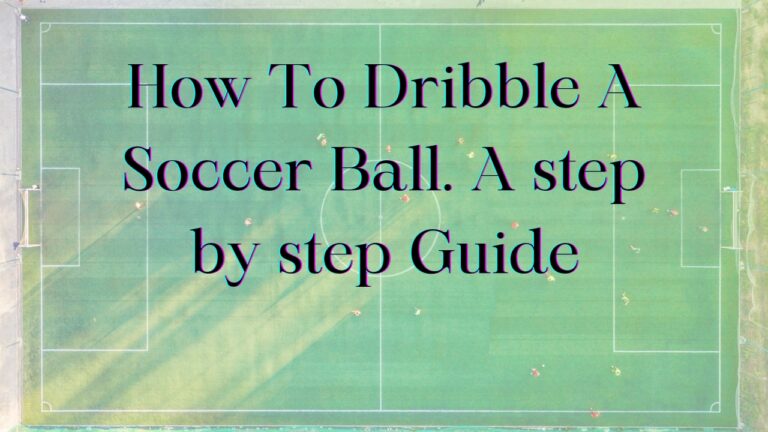Passing is one of the most fundamental and strategic skills in soccer. Many different types of passes serve different purposes in the game. Mastering when and how to use all the pass types is crucial to controlling possession, building up play, and creating chances. This comprehensive guide will examine the key passing techniques when to use each type of pass, common mistakes to avoid, and drills to sharpen your passing skills.
The Key Types of Passes in Soccer
Short Passes
Short passes are quick ball exchanges over a short distance, typically using the inside of the foot. They are essential for maintaining possession and working the ball up the field with patience. Disguising these passes and using fluid movement off the ball creates passing angles to advance play.
Long Passes
Long passes switch play from one side of the field to the other or play the ball over 20+ yards upfield directly. They require more power, usually using the laces. Long diagonal switches stretch the defense, and quick long passes can spring counterattacks.
Through Passes
Through passes, split the defensive lines and play the ball into space behind the defense for an attacking teammate to run onto. They require perfect weight, timing, and vision to execute. Unlocking a defense with an incisive through ball is exhilarating.
Crosses
Crosses are passes played from near the touchline into the penalty area, seeking to connect with a teammate to finish with a header or volley on goal. Early whipped crosses can catch defenders off guard.
Back Passes
Back passes go backward to a defender or midfielder, often used to reset the attack or relieve pressure when under heavy defense. Though they are sometimes cautious, they have strategic value in controlling the game.
Flick-Ons
Flick-ons involve using the head to gently redirect the ball to a teammate without gaining full control. Flick-ons maintain attacking speed.
One-Touch Passes
One-touch passes involve playing the ball first-time to a teammate without controlling it. Quicker one-touch passing requires sharp technique, awareness, and chemistry.
Give-and-Go’s
Give-and-go’s are short exchanges where the passer immediately makes a run to receive the ball back from the returning passer. The quick 1-2 exchanges unlock defenses with clever movement.
Through Balls
A through ball is a pass played into the space behind the defense for an attacking teammate to run onto. Perfectly timed through balls can devastate defenses.
Executing the Fundamental Passing Techniques
Mastering passing techniques provides the foundation for soccer players to make all types of passes in games.
Inside of the Foot
Passing with the inside of the foot generates a crisp, accurate short to medium-range pass. The inside-of-the-foot technique is vital for controlling games.
Laces
Laces passing involves a powerful strike through the ball’s center with the top of your shoelaces. Laces generate speed for longer passes and shots.
Outside of Foot
The outside-of-the-foot technique bends the ball around defenders or passes at awkward angles where using the inside of the foot is not suitable.
Thighs and Chest
Controlling the ball with the chest and thighs allows players to cushion passes and prepare the ball to return cleanly to teammates.
Heading
Passing by heading is an unavoidable necessity in soccer to clear lofted passes. Heading accuracy helps maintain possession and switch the point of attack.
Choosing the Right Type of Pass
Selecting the appropriate pass type sets up attacking opportunities while minimizing turnovers. It’s crucial to quickly assess the position of teammates, defenders, and space on the field to make smart passing decisions. Patience, vision, and understanding of teammates’ strengths are vital skills. Some general principles:
– Use short passes to probe patiently when defenders sit deep. Switch play to change their shape.
– Play long passes or through balls to unleash quick counterattacks when space opens up.
– Cross early if fullbacks push upfield and create 2v1 overloads.
– Make back passes to draw opponents upfield and open space behind them.
The right passing decisions keep possession, progress play, and ultimately create high-quality goal-scoring chances.
Common Passing Mistakes to Avoid
Some bad passing habits can easily develop. Being cognizant of these tendencies helps players correct them.
Telegraphed passes – Disguise passes and use eye fakes. Predictable passes are easy to intercept.
Underhit or overhit passes – The weight and pace of passes must match the situation.
Passing to marked teammates – Keep the ball moving quickly to stay ahead of pressure.
Passing behind a player’s run – Recognize visual cues to deliver the ball precisely into stride.
Dwelling on the ball – Think ahead and move the ball before pressure arrives.
Drills to Improve Passing Skills
Dedicated practice establishes muscle memory and automatic play. These passing drills drive improvement.
–One-touch and give-and-go drills – Quick exchanges improve first touch and instinctive passing.
– Passing between cones – Pass through cones to ingrain accuracy. Move cones further apart to drive power.
– Passing on the move – Passing while dribbling deepens coordination and multi-tasking.
–Boundary passing – Rapid passes between players while staying within the cones improve switching the point of attack.
– Passing under pressure – Adds defenders to sharpen composure and decision-making when closed down.
Related Post: 3 Drills to Improve Your Ball Control in Football For Beginners.
Famous Passers in Soccer History
Legends like Xavi, Pirlo, Beckham, and Laudrup took passing to an art form with their vision, creativity, and flawless technique:
– Xavi – The midfield maestro famous for his precision short passing game, controls matches with masterful orchestration of possession.
– David Beckham – Beckham redefined crossing and set-piece passing, being able to place pinpoint 50-yard passes regularly.
– Andrea Pirlo – Pirlo utterly dictated games with his full passing range, dictating the tempo with both surgical and incisive passes.
– Michael Laudrup – Laudrup had immaculate touch and weight on passes, unlocking defenses with perfectly timed through balls.
Importance of Passing in Soccer
Passing is the foundation that makes soccer “The Beautiful Game.” Precise passing moves the ball efficiently upfield while interceptions and tackling waste energy. Teams with world-class passing control games, dominate possession and unlock defenses at will. While each position makes specific passing contributions, every player must pass decisively and creatively to fully express their talents on the pitch. Crisp, imaginative passing is soccer at its very best.
In summary, mastering the full range of soccer passing techniques, types, and decision-making is essential for controlling possession, unlocking defenses, and creating scoring opportunities. Passing moves the game. Keep practicing the passing drills, study the great passers, and let your soccer imagination flow freely!
Related Post: 3 Drills to Improve Your Ball Control in Football For Beginners.





